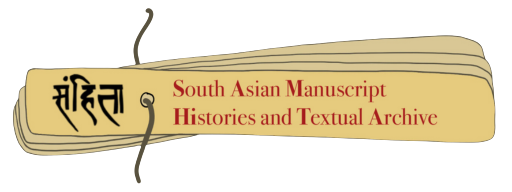SAMHiTA: South Asian Manuscript Histories and Textual Archive
SAMHiTA is an initiative to create a relational database and digital archive of Indian and broadly South Asian manuscripts housed in libraries, archives and other repositories outside India, through collaboration with institutional partners. The word ‘samhita’ in Sanskrit means ‘collection’ or ‘compilation’. SAMHiTA’s goal is to consolidate information dispersed across institutions on an online platform accessible to all.
India’s learned inheritance spans fields including medicine, mathematics, architecture, philosophy, aesthetics and literature. Its continuous transmission from ancient times was largely through an oral tradition and through hand-written texts (manuscripts) in different languages such as Sanskrit, Tamil, Odia, and Bengali, and scripts like Nagari, Grantha, Sharda, Newari among others, written on materials such as copper plate, birch bark, parchment, and palm leaf.
From around the 2nd–3rd centuries CE, texts fanned outwards from the Indian subcontinent to regions like Balkh, Xinjiang, Tibet, Japan, Thailand, and Bhutan. From the 18th century, Europeans began taking an active interest in Asian history, religion, philosophy, and literature. Many manuscripts were collected and taken to the West.
Today, Indic manuscripts are scattered across Asia, Europe, and North America. SAMHiTA is the first attempt to bring together repositories from outside India and South Asia on a common platform. The information collected will be shared on PANDiT: Prosopographical Database of Indic Texts and Records, a database on South Asian intellectual history.
Ministry of External Affairs
Development Administration Partnership (DPA) was created in the Ministry of External Affairs in January 2012 to handle India’s aid projects through concept, launch, execution and completion. DPA IV created in January 2020, is the nodal point for dealing with heritage restoration projects carried out by the Indian Government. It contributes to the restoration of cultural heritage in the region from Sri Lanka to Myanmar to Vietnam to Bhutan.The overarching aim is to revive and display India’s cultural and heritage linkages with other countries.
The Ministry of External Affairs has completed over 49 projects all around the globe which includes cultural and heritage restoration projects in Malaysia, Mongolia, Bahrain, Israel, Turkestan, France, Myanmar, Sri Lanka, Maldives, Afghanistan, Nepal, Bhutan, Indonesia, Africa, Cambodia, Myanmar, Laos, and Vietnam. DPA IV also plans to promote restoration and revival of Intangible Cultural Heritage like language, rituals, practices, performing and other fine arts in an institutional manner, and, through SAMHiTA, to scripture preservation and digitization of manuscripts.

